Pasta Puttanesca (spaghetti alla Puttanesca) is a classic Italian dish made with spaghetti, tomatoes, olives, capers, and anchovies. This delicious and aromatic pasta will be ready in just 20 minutes! It’s intensely seasoned and made with just a few pantry staples. It makes a great weeknight dinner or date night dinner idea!
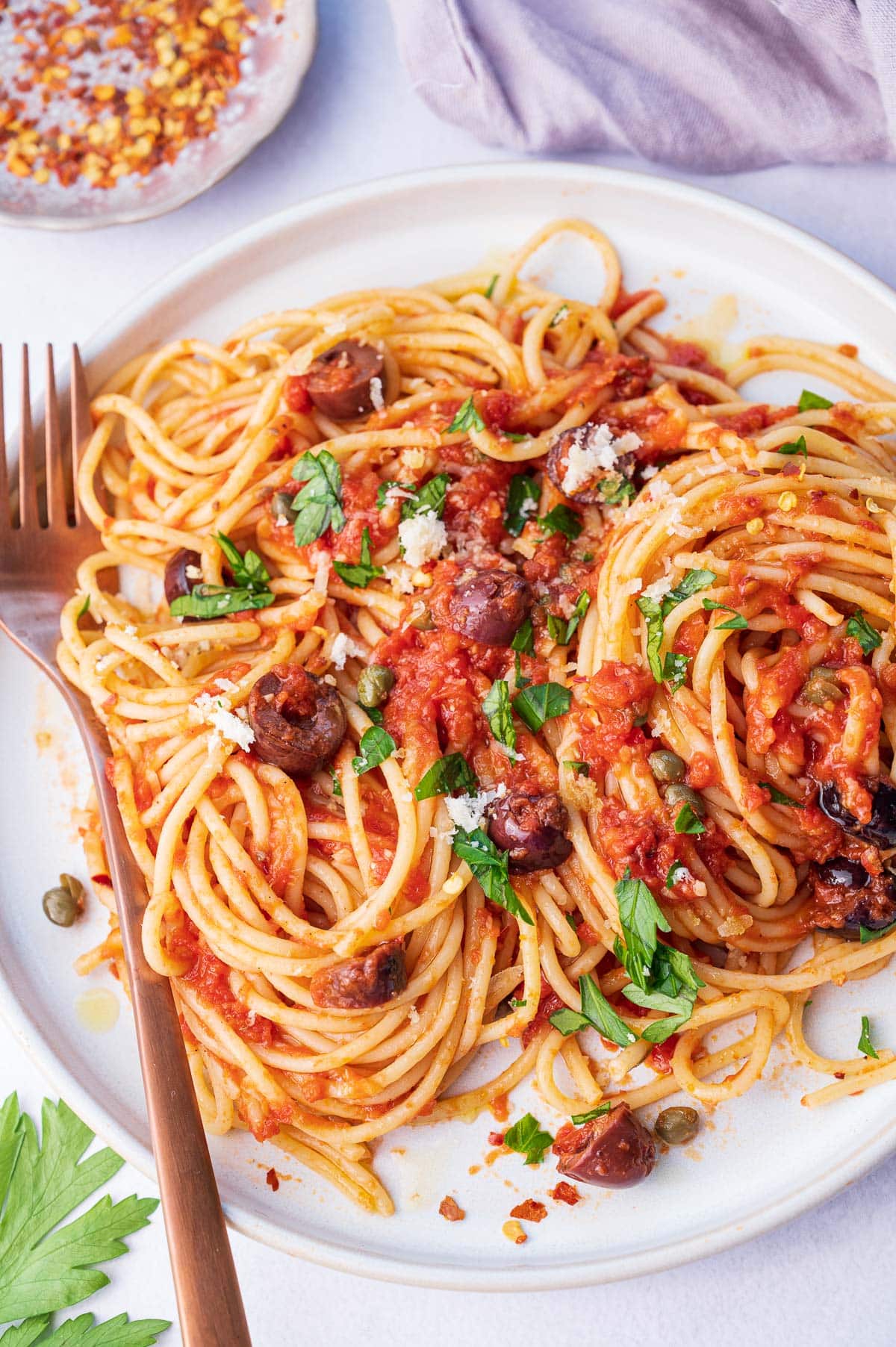
History of the dish
This dish comes from the region of Italy called Campania, from the area around the city of Naples. It became popular around 1960. Its name can be literally translated as spaghetti in the style of a prostitute. It was allegedly invented by courtesans, who needed to prepare a quick meal made with a few easily available ingredients, which was supposed to fulfill them between appointments. The fragrant and aromatic sauce was also supposed to lure potential customers.
There is also a second, more likely theory of the dish’s creation – pasta would be invented by Sandro Petti, co-owner of a restaurant on the island of Ischia. One evening, he had to serve a group of guests who, despite the late hour, did not want to finish the celebration in the restaurant and demanded more food. To the chef’s answer that his supplies were over, they were to say – ‘put anything you have on hand in the sauce and it will be fine!’ So Sandro put a couple of his pantry staples and so this dish came to life.
In Italian, there is a word ‘puttanata’, similar to ‘puttanesca’ which means ‘something worthless’ (to put it nicely). Spaghetti alla puttanata did not sound very good, so he called it spaghetti alla Puttanesca. After he added this dish to the menu of his restaurant, it gained popularity quite quickly.
Ingredients
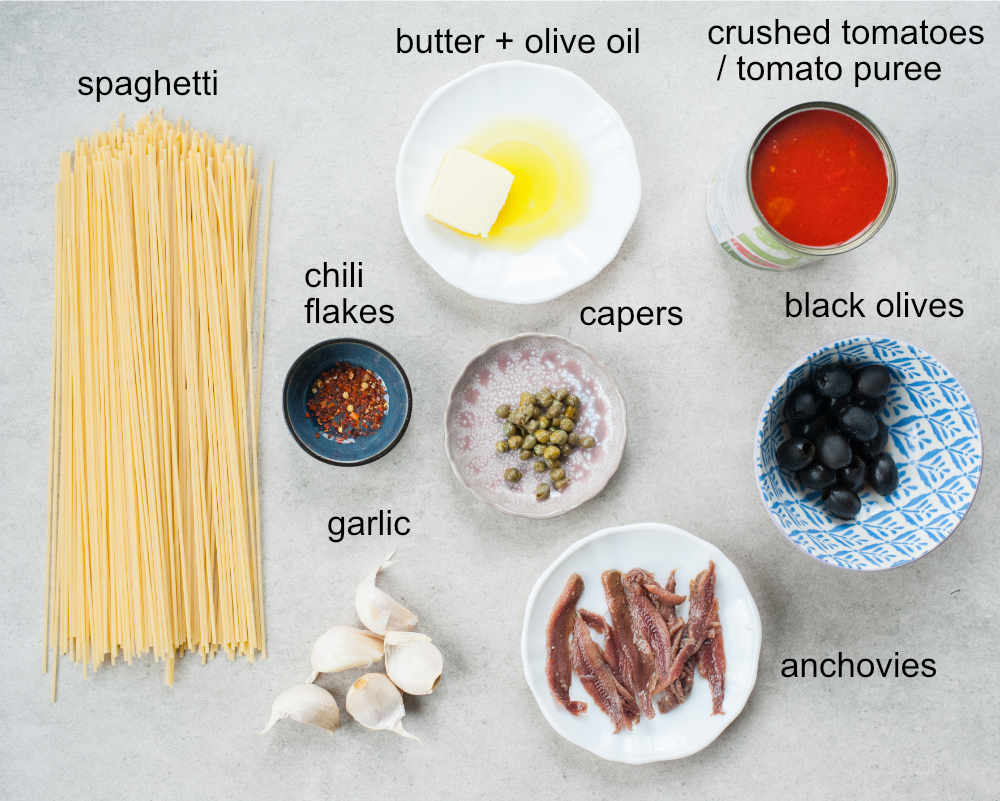
This is such a simple dish – you need just a couple of ingredients to make it. It’s great as a main dish or served with soup or a salad. You could also serve smaller servings as an appetizer.
Here’s what you need:
- Pasta – I used spaghetti – this type of pasta works best with this recipe.
- Tomatoes – I recommend using crushed tomatoes in a can or tomato passata (tomato puree) in a jar. Tomato passata produces smoother sauce. I don’t like to use diced tomatoes here, but they can be used. There is not enough time for them to cook down to a sauce so it’s better to use crushed tomatoes or tomato passata/puree. You can also just quickly blend diced tomatoes with a hand blender if this is what you have on hand. Don’t use tomato paste.
- Garlic – I love garlic so I used a lot of it in this recipe. Note that this recipe calls for chopped garlic. Do not press the garlic through a garlic press – its taste will be too sharp/harsh. This article from Serious Eats explains well differences between the pungent taste of garlic depending on which method of mincing the garlic you have used.
- Chili – this dish should be spicy! Add as many chili flakes as you like. I’m not adding much since I’m feeding this to my toddlers (they love it but won’t eat olives!).
- Anchovies – they are very small oily fishes that have incredible taste. Don’t worry, though, this pasta won’t taste fishy! Anchovies add umami flavor to the dish. What’s umami? You can think of it as a meaty, complex, and rich flavor, the kind soy sauce and Parmesan cheese add to the food. I’ve read some interesting things about anchovies here in Wikipedia: anchovies were used in ancient Rome to make Garum – a fermented fish sauce – a condiment that was used to add flavor to many dished at that time. Anchovies were also eaten raw as an aphrodisiac! Nowadays, anchovies are used to make for example Worcestershire sauce – it’s very flavorful and I add it to many dishes (it enhances the flavor of this cabbage roll soup or creamy mushroom sauce). I’m adding quite a lot of anchovies to my pasta in comparison to other recipes that can be found on the internet. It’s just when I was adding less I thought the pasta is lacking some flavor. 10 small fillets (0.9oz/25g) hit the sweet spot for me (the pasta won’t taste fishy though, sauteeing them in olive oil and butter tames their fishy taste somehow, leaving just the most amazing flavor). Feel free to use less if you wish, you can add even just 2 fillets. Anchovies are usually sold in small jars in oil (this is what I’ve used).
- Anchovies are one of the main ingredients in this dish so I would not recommend omitting them. They’re really “the secret ingredient” and what makes this dish special.
- Whole anchovies have a better flavor than an anchovy paste. They also have a longer shell life.
- If you’re wondering what to do with the rest of the anchovies jar, you can make Caesar salad dressing or this Nicoise salad dressing! They also freeze really well.
- Olive oil and butter – traditionally only olive oil is used but I like to mix it with butter for its taste.
- Capers – they are usually sold in small jars in a vinegar brine. I usually rinse them, otherwise, they taste too vinegary for me. If you’re new to eating capers you can add less at first and increase their amount as soon as you’re accustomed to the flavor.
- Olives – I like kalamata but any type of olives can be used.
- To serve – chopped parsley and parmesan cheese. Parmesan cheese is optional, the pasta tastes great also without it, it’s also not very traditional in this recipe, but honestly, I’m adding it to any kind of pasta.
- Instead of parsley, you could add fresh basil. I prefer parsley over basil in this dish.
- What you could also add: canned tuna is a popular addition to this recipe and it makes it more filling. You could also add diced and pan-fried chicken. Lemon zest would also be a lovely addition.
How to make pasta Puttanesca step by step
This is a complete recipe. Scroll down for a printable recipe card.
Start with cooking 8 oz (225g) spaghetti noodles. They should be cooked al dente, which means they should have a bite to them, don’t overcook the pasta! Cook it in a small amount of well-salted water then reserve about a ½ cup of the pasta cooking water (!).
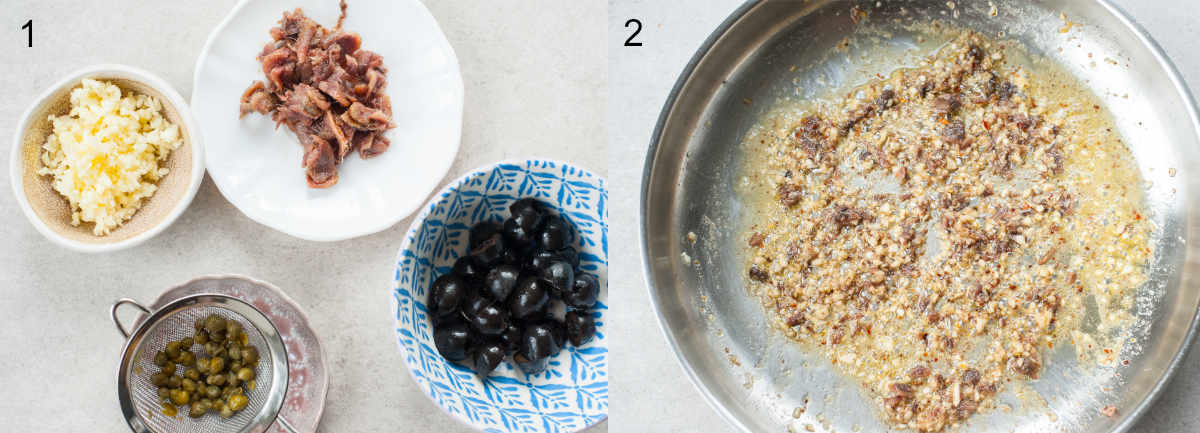
STEP 1: Prepare the ingredients: finely chop 5 cloves of garlic, roughly chop 10 anchovies (0.9oz/25g), drain and rinse 2 Tbsp of capers, and cut 15 olives in half.
STEP 2: Heat 1 Tbsp of olive oil and 1 Tbsp of butter in a large frying pan, add the garlic, 1/2 ts (or more, to taste) chili flakes, and anchovies. Cook over medium heat, stirring, for 1 minute.
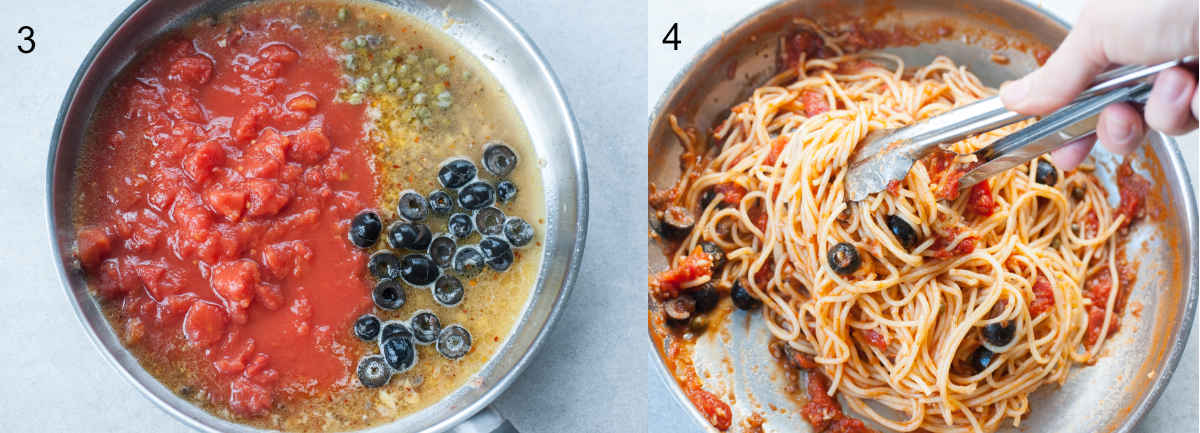
STEP 3: Add the olives, capers, crushed tomatoes/tomato passata, and pasta cooking water. Bring to a boil, reduce the heat to low, and cook for 15 minutes (stirring from time to time) until the sauce is thickened.
After this time, season the sauce lightly with salt and pepper. Be careful with adding salt (!), because anchovies, olives, and capers are already salty. Take the pan off the heat.
STEP 4: Add the cooked pasta to the pan, toss with the sauce.
Sprinkle with chopped parsley, grated parmesan, and serve immediately.
Enjoy!
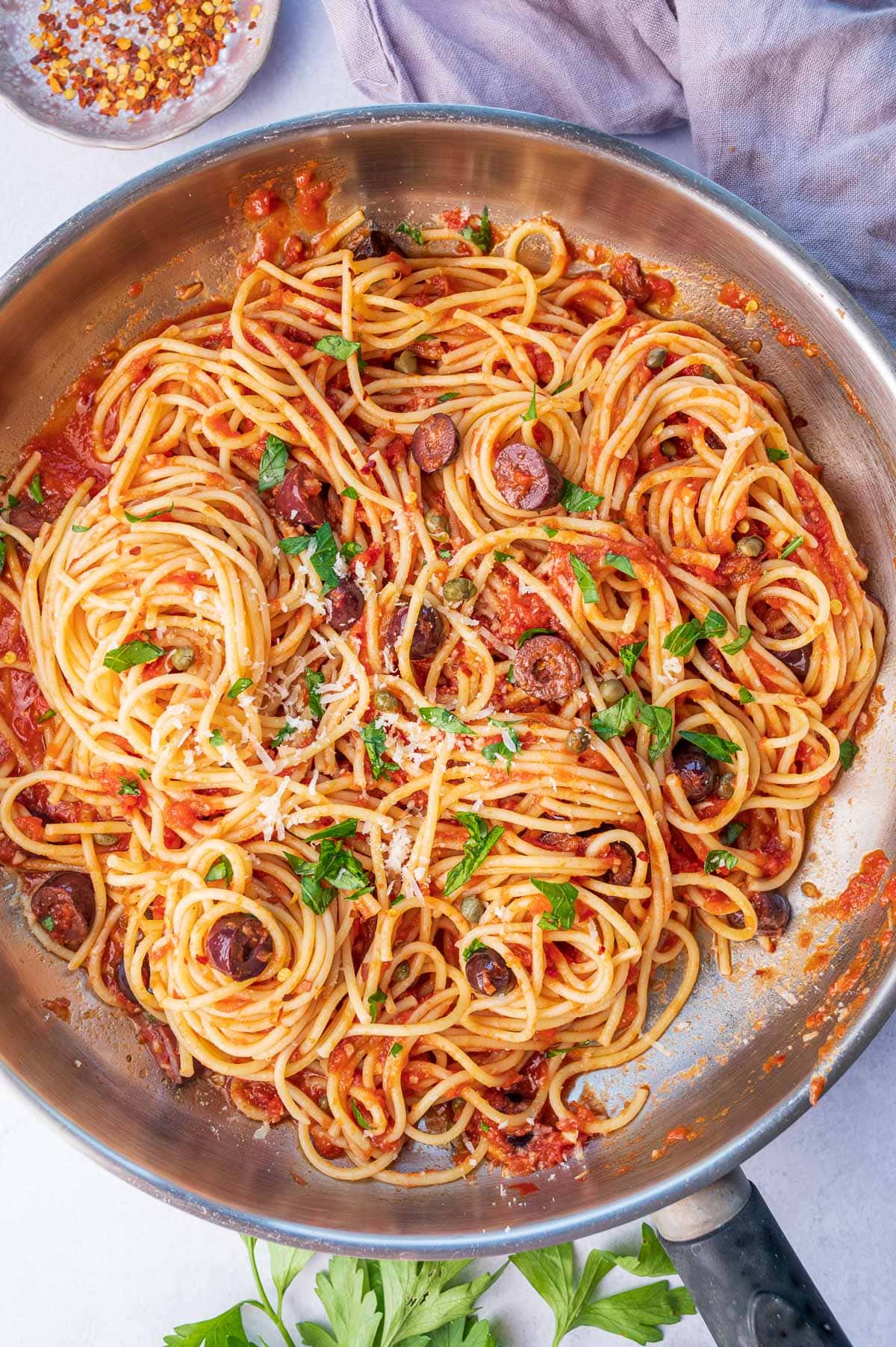
Storage
This dish reheats really well. Store it in the fridge for up to 3-4 days, reheat in a non-stick pan.
It would be better to store the pasta and the sauce separately to avoid mushy pasta but this is just a suggestion. This pasta will still be good.
Serving suggestions
- simple salad with vinaigrette
- Caesar salad (minus the chicken and eggs)
- Caprese salad
More quick pasta recipes you may like
- Burrata Pasta
- Tuscan Chicken Pasta
- Caprese pasta – tomato, mozzarella, and basil pasta
- Lemon Broccoli Pasta
- Spaghetti cacio e pepe
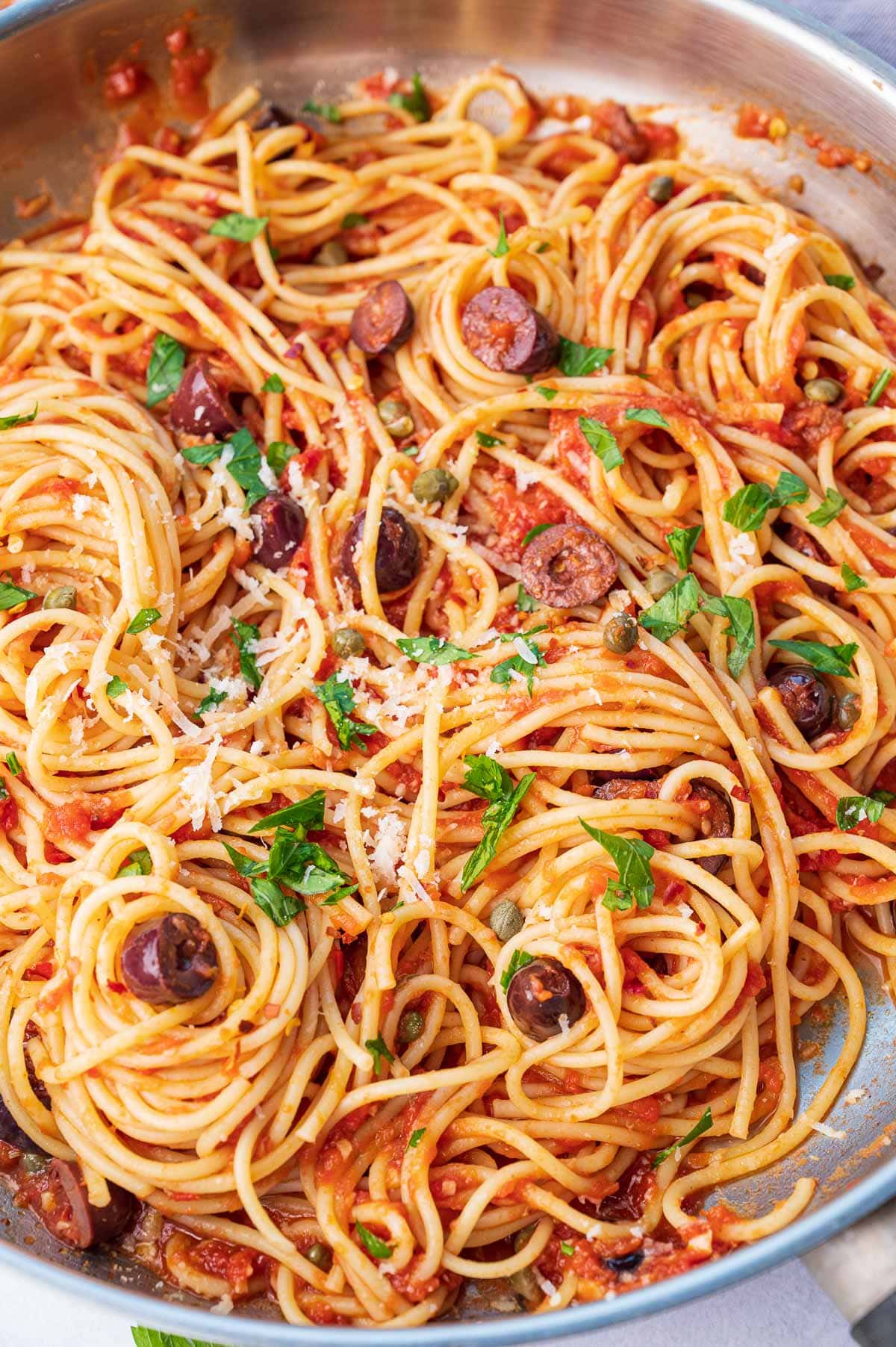
Did you make this recipe? RATE THE RECIPE or tell me in the COMMENTS how you liked it! You can also add a photo of your dish. It would make me very happy and will help other readers. Thank you!!
Pasta Puttanesca
Ingredients
- 8 oz (225g) spaghetti pasta
- 1 tablespoon olive oil
- 1 teaspoon butter or olive oil
- 5 cloves garlic finely chopped (with a knife)
- ½ teaspoon chili flakes or to taste
- 10 anchovies in oil drained and roughly chopped
- 15 kalamata olives (or black) pitted and cut in half
- 2 tablespoons capers drained and rinsed
- 1 can crushed tomatoes (14 oz / 400g) or tomato passata/tomato puree
- ½ cup pasta cooking water
- ½ teaspoon sugar optional
- salt and black pepper to taste
- 3 tablespoons chopped parsley to serve
- grated parmesan to serve
Would you like to save this?
Instructions
- Cook the spaghetti al dente (it should have a bite to it) in a small amount of well-salted water. Reserve about a ½ cup of the pasta cooking water (!).
- Prepare the ingredients: finely chop the garlic (do not use a garlic press), roughly chop the anchovies, drain and rinse the capers, and cut the olives in half.
- Heat the olive oil and butter in a large frying pan, add the garlic, chili flakes, and anchovies, cook over medium-low heat, stirring, for 1 minute.
- Add the olives, capers, crushed tomatoes/passata, and pasta cooking water. Bring to a boil, reduce the heat to low and cook for 15 minutes (stirring from time to time) until the sauce is thickened. After this time, season the sauce lightly with salt and pepper. Be careful with adding salt, because anchovies, olives, and capers are already salty. Take the pan off the heat.
- Add the cooked pasta to the pan, toss with the sauce.
- Sprinkle with chopped parsley, grated parmesan, and serve immediately.
- Enjoy!
Notes
- Although there are 10 anchovies listed in the ingredient list, don’t worry, this dish won’t taste fishy.
- Servings: 2 dinner servings or 4 appetizer servings. These are light dinner serving, to make this more filling you can add canned tuna to the dish.
- How to season the pasta to your liking: I added sugar to my recipe because my tomatoes were a little on the sour side. You can omit the sugar. Add a pich at first and taste the sauce. If it tastes too sour or you feel it lacks ‘something’ it’s probably either lack of salt or sugar. If it turns out too sweet you can add more capers or balsamic vinegar (or lemon juice) to the sauce.
- Calories count = 1 serving (1/2 of the recipe).

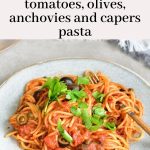
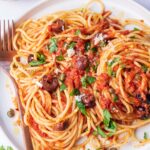

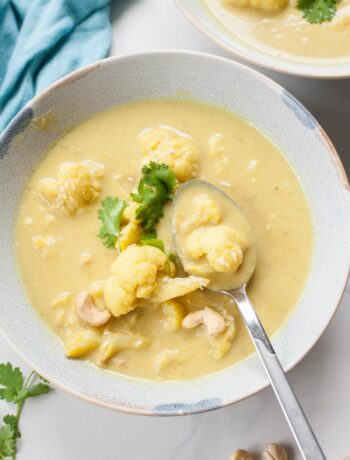
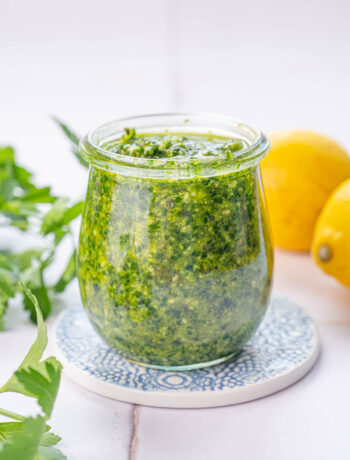
No Comments